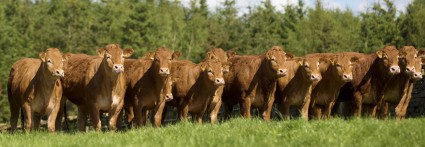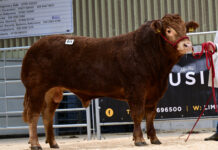The first of their kind for the UK beef industry, Genomic Breeding Values (GEBVs) for a range of new carcase traits in Limousin cattle were successfully launched at the recent October bull sales in Carlisle and Stirling.
Already established in other livestock sectors, GEBVs herald an exciting new era in evaluating the genetics of Limousin-bred beef cattle. They are estimates of genetic merit using truly new and independent sources of information; visual image analysis (VIA) records on individual carcase cuts from selected ABP abattoirs and information from a vast pool of Limousin DNA combine to produce breeding values that indicate an individual animal’s strengths and weaknesses for each trait. The evaluation is carried out by Egenes (a unit in Scotland’s Rural College (SRUC) and the GEBVs are reported back to industry through the Limousin Society database, alongside all the traditional Estimated Breeding Values (EBVs).
The use of VIA technology in ABP’s abattoirs identifies significant differences in carcase value that are not always apparent under the EUROP grading system. Capture of this information and its use in the Limousin genetic evaluation will enable breeders to select breeding animals with high genetic merit for traits that add value to their calves.
Says Dean Holroyd, Group Technical and Sustainability Director with ABP Food Group, “some work carried out in the research stages looked at the progeny of 259 Limousin sires. Significant ranges in genetic potential for the different carcase cuts were clearly identified between the best sires and the poorest sires vs the average. This has led us to embark on the introduction of a more sophisticated EUROP grid currently in consultation. Identifying the sires that can leave the progeny that will do this has obvious benefits along the whole of the supply chain”
When the additional value of all the cuts is multiplied up, it equates to an estimated difference of around £100-£150 per calf (source: Meat Prices Index) between the best and poorest sires. Half of a calf’s genes come from its sire; assuming all things are equal, this means the sires with superior carcase genetics have the ability to produce calves worth £50-£75/head more than the sires with poorer carcase genetics. So identification and selection of the correct service sire is becoming increasingly important.
On a wider level, further advantages of GEBVs include:
- Data from independent sources: Use of independent abattoir records and animal DNA represents a significant step forward in the data used for genetic evaluation. On-farm recording will remain important, however; GEBVs are not effective in isolation since they require ongoing recalibration.
- Speed: GEBVs can be obtained shortly after a calf is born, thereby enhancing the opportunities for selection much quicker than performance recording alone. They are particularly valuable for traits that can only be measured later in life.
- Improved accuracy: For many traits that have low heritability or are particularly difficult or expensive to measure, GEBVs will offer higher levels of accuracy than conventional EBVs.
- Lower Cost: Because accuracies are enhanced much more quickly using GEBVs than collecting records on-farm (depending on the trait) there can be less cost involved in getting breeding value estimates to similar levels of accuracy.
- All owners of Limousin-bred cattle can gain GEBVs: A significant difference between an EBV and a GEBV is that the former relies on the collection of performance records across groups of animals all managed in the same way. To gain the latter – a GEBV – all that is required is the DNA sample and the identity of the animal. It offers commercial producers significant opportunity in assessing current and future sires and replacement heifers.
Professor Mike Coffey from SRUC says “This is a game changer for the beef industry. Genomic selection will bring large and rapid benefits to beef breeders and processors in the same way it has for the dairy industry. It will enable the UK beef sector to remain internationally competitive and will provide a platform for the future that will include other economically important traits such as feed intake and meat quality.”
GEBVs will be used in exactly the same way as EBVs when breeding decisions are being made by commercial and pedigree breeders alike. Albeit they have been produced in slightly different ways, they are in essence breeding values that indicate genetic merit and the way producers use them should not differ. As with the traditional EBVs, the numeric values and accuracies will be shown for each GEBV, along with a bar chart illustration from the end of this year. For additional information, it will be clear which traits are EBVs and which are GEBVs i.e. those which have been derived from on-farm measurements alone and those which have also used information from the animal’s DNA.
Says Iain Kerr, Chief Executive of the British Limousin Cattle Society “this is an important time for genetic evaluations in the beef sector in this country. The heightened benefits of genomic selection are making themselves very evident in other species and it is very encouraging that the beef sector should now have this technology available to it. Producers of Limousin-bred cattle now have even sharper tools available to them to select cattle that have the genes to supply an end market whose pricing structure is evolving to favour the animals that truly perform for the higher value cuts. Investment in such technologies is part of the Society’s 10 year Breed Improvement Strategy and provides industry with further very good reason to incorporate Limousin within their breeding programmes”
Towards the end of this year and in to the early part of 2016, the project partnership will launch Genesure Ltd, providing the vehicle by which all Limousin producers may obtain GEBVs for their animals. This will be followed by the first commercially available animals with GEBVs in the Spring of 2016.


















